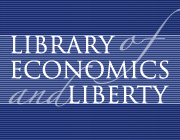
James Edward Meade |

In the second volume, Trade and Welfare, Meade examined conditions under which free trade made a country better off and conditions under which it did not. Meade concluded that, contrary to previous beliefs, if a country was already protecting one of its markets from international competition, further protection of another market could be "second best." That is, although the ideal would be to eliminate all protection, if for some reason this was not feasible, then adding a carefully chosen dose of protectionism could improve the nation's economic well-being.
Like Milton Friedman in the United States, Meade wanted to use economics to help make the world a better place, and believed that government regulation often harmed an economy. Unlike Friedman, he believed that government should take strong measures to promote equality of income. Said Meade: "I have my heart to the left and my brain to the right."
Meade also helped prepare the British government's set of national income accounts during World War II. Meade was a professor of commerce at the London School of Economics from 1947 to 1957 and then moved to Cambridge University, where he taught until he retired in 1974.
A Geometry of International Trade. 1969.
The Theory of International Economic Policy. Vol. 1, The Balance of Payments, 1951; Vol. 2, Trade and Welfare, with "Mathematical Supplements."
